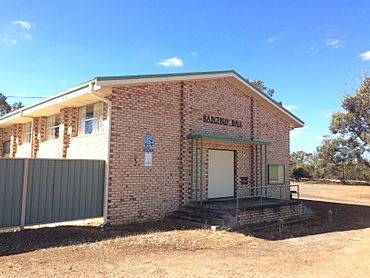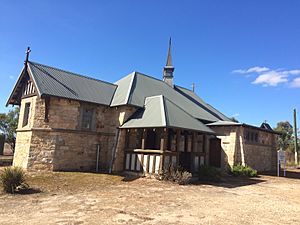Badgebup, Western Australia facts for kids
Quick facts for kids BadgebupWestern Australia |
|
|---|---|

Badgebup Hall 2018
|
|
| Established | 1923 |
| Postcode(s) | 6317 |
| Elevation | 306 m (1,004 ft) |
| Area | [convert: needs a number] |
| Location |
|
| LGA(s) | Shire of Katanning |
| State electorate(s) | Roe |
| Federal Division(s) | O'Connor |
Badgebup is a small town in the Great Southern region of Western Australia. It is located between the towns of Katanning and Nyabing. Badgebup is about 270 kilometers (168 miles) southeast of Perth, a major city.
North of the town, the Badgebup Reserve is part of the Kwobrup-Badgebup Important Bird Area. This area is special because it protects many different kinds of birds.
Contents
What's in a Name?
The name Badgebup comes from a nearby well. It is an Aboriginal word. People think it means "place of the wild rushes" or "broad green leaves on a plant around a soak".
The town's name has changed a few times. It was first called "Badjebupp" in 1923. Then it changed to Nalabup, and back to Badjebupp in the same year. Finally, in 1972, it became Badgebup.
A Look Back: Badgebup's History
The first people to settle in the Badgebup area arrived in 1873. H. Hayward was one of the first to claim land here.
Community Buildings
The Rockwell Agricultural Hall was built in 1907. Local residents F.H. Flugge and J.C. Warren suggested building it. This hall was used for community events and also as a schoolroom. Later, an engine room was added in the 1950s. The local tennis club added a storage room in the 1990s.
Another Agricultural Hall was built in Badgebup in 1918. A. Reid from Katanning constructed this building.
St. Peter's Church
St. Peter's Church was built in 1922. It was a special memorial for John Campbell Warren. He was the son of a local farming family who died during World War One.
The Warren family had settled in the area in 1897. The stone for the church came from their property. The local community worked together to build the church. Today, the church's remains are considered a heritage site.
Community Life and Changes
The Badgebup branch of the Country Women's Association (CWA) started in 1934. The CWA helps women in rural areas. Mrs. Toms was chosen as the first president.
The local school closed in the 1940s. The last shop in town closed in the 1950s. After that, people in the area had to go to Katanning for services.
Bushfire in 2004
In 2004, a large bushfire swept through the area. It destroyed crops, sheds, and homes. Volunteer firefighters worked hard to stop the fire. Sadly, two homes and three sheds were lost. One shed even had several vintage cars inside.
Farming in Badgebup
Today, the main industry in Badgebup is wheat farming. The town is a Cooperative Bulk Handling site. This means it's a place where farmers bring their grain to be stored and transported.



